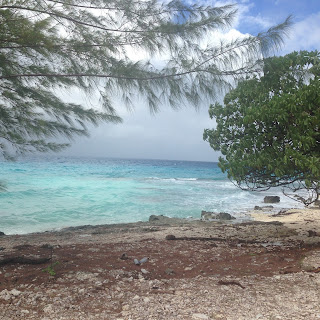 After visiting so
many volcanic, lush islands, the flat landscape of the Rangiroa atoll seemed
stark and desolate. This atoll, the second largest in the world, boasts some of
the world’s best scuba diving. On the cloudy, humid day I visited Avatoru, one
of only two main villages, the intermittent storms and wind made for some
choppy surf.
After visiting so
many volcanic, lush islands, the flat landscape of the Rangiroa atoll seemed
stark and desolate. This atoll, the second largest in the world, boasts some of
the world’s best scuba diving. On the cloudy, humid day I visited Avatoru, one
of only two main villages, the intermittent storms and wind made for some
choppy surf.
I rented a bike
to travel the single road that connects several small
islets for about 6 miles.
Tucked among some palm tree groves are some pensiones, and a few places serving
food for the tourists who come to dive or relax at the sea. Although Avatoru is
not rustic—it has running water, cars, and electricity—it definitely represents
“island life” on a very small scale.
At the far end of
the island, after pedaling through the village “center” [it had a food
shop and a bank], I came upon an old church overlooking a pass. An abalone
altar and
waterfall added to the stillness of this refuge from the sudden burst
of rain. The ride back, into the unforgiving wind, gave me some time to view
the pristine beauty of this tropical paradise. The wind, the waves, and the
salt air felt pure and cleansing. When
the sun appeared later in the day, I floated out in the lagoon to look at the
beautiful fish hiding in the coral.
The end of this
idyllic day included a walk to the beach on the other side of the island. Some
entrepreneurial young villagers had set up a stand selling purples shells, and
they practiced some French and English they had learned to drive a hard
bargain. The beach nearby had huge chunks of coral and shells that would
eventually be pummeled into sand by the fierce waves on that side of the
island. The contrast of the fierce, roaring waves with the strong wind to the
peaceful surf of the lagoon only a few minutes’ walk away was mind-boggling.
Sometimes nature reflects life.




